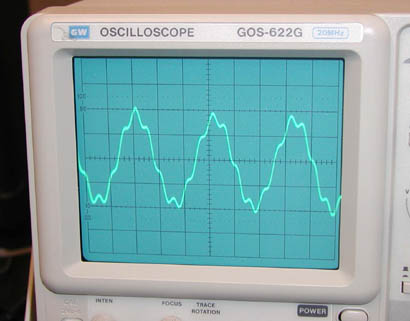So you've finished your guitar. All the strings are in place; all the electronic parts are wired together. The only thing is, when you play the strings, you hear not a nice chord but a muddle of wrong, out-of-tune notes. Clearly, you're not quite done, you still need to tune your guitar.
If you're already a musician, here's the quick guide to tuning: Tightening a string makes its pitch go up; loosening it makes the pitch go down. It only takes a tiny fraction of a rotation of the tuning knobs (you did realize that they are how you tighten the strings, didn't you?) to change the pitch significantly, so go slowly. We're tuning the strings to low G, D, G (an octave up), and B; you can tune them to whatever you want, as long as you know that tightening the strings too much can snap either them or your guitar.
If you're not a musician, or you aren't great at tuning by ear effectively, here is a more detailed explanation of tuning. As you no doubt know if you have read the rest of this website, guitar strings make sound by vibrating. In an acoustic string instrument, this vibration causes a resonating effect in a large wooden pocket, thus amplifying the sound; in an electric guitar, a magnetic pickup "picks up" these vibrations and transfers them to an electric circuit, where they are amplified and played back through a speaker. The amplitude of the pressure wave formed is directly related to how loud we perceive the sound as being (see the Sound section); the frequency of the wave determines the "pitch" of the note, how "high" or "low" the note sounds.
As mentioned before, the tightness (and the length and composition, but we use tightness for tuning on guitars) of a string determines its frequency, and thus the pitch of the note it produces. Also, as mentioned above, we're tuning the strings to a low G, D, G (an octave up), and B. So what does this mean? Musicians developed a system of letters to denote assorted pitches long before sound was fully understood. They arranged notes into "octaves", a note that is an octave above another note sounds a great deal like that other note, but not exactly the same. In an octave, the main frequency of the lower note is exactly half of the frequency of the higher note; in the case of the two Gs on this guitar, the lower one's frequency, when in tune, is 96 Hertz, or cycles per second; the upper one, therefore, is 192 Hz.
On a typical instrument, the note, when graphed (incidentally, these oscilloscope graphs represent voltage versus time, and the voltage varies directly with the pressure of the sound wave), isn't a single sine wave; it is in fact the sum of a number of different sine waves. Each instrument has a signature pattern of sine waves that add up to make a note on that instrument; that is how we can tell different instruments apart. One of the sine waves that is added to the base frequency of the note by many instruments is a wave with twice the frequency of the base note, the same frequency as the octave note. This is why octaves sound similar.

Complex sinusoidal waves on an oscilloscope.
Now, on to the tuning. The goal of tuning is to get the string to be exactly the right tightness, so that it vibrates exactly at the intended frequency. There are two ways to do this: One is to use an electronic tuner. Put the tuner right next to the guitar in a quiet room, or plug the guitar into the tuner if the tuner has this ability. Then, pluck one of the strings; if the tuner indicates that the note is too low (or "flat"), tighten the string, and if it indicates that the note is to high (or "sharp"), loosen the string. The other method for tuning is to tune "by ear": Simply play the note that you want to tune one string of the guitar to on an instrument that you know to be in tune, such as a piano or an electronic keyboard, and then play the string that you are tuning. If the string sounds sharp, loosen it, and if it sounds flat, tighten it. Be wary of tuning by ear to a non-string instrument; I personally find it much easier to tune within an instrument class, and in any case, some wind instruments are based on a shifted scale. A Bb on a trumpet, for example, is the same as a C on a piano, is the same as an Eb on an alto saxophone, etc. Hey, it's tradition...
For more detailed information on how sound works, see the section devoted to that topic. The section on sound also contains a few tips that may help fine-tune your tuning skills.
Incidentally, if you want to mark off the IV and V positions on your guitar, click here.
Click here to return to the Stringing Guitar section.
